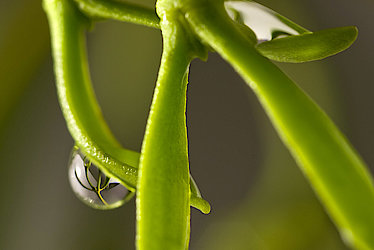Effects and efficacy
Challenges in clinical mistletoe research
Essential effects of mistletoe therapy:
- The quality of life increases
- The immune system is activated in terms of an immunomodulation
- The number of immune cells increases again if they were previously reduced.
- The growth of cancer cells is reduced (proliferation inhibition)
- Cancer cells are stimulated to die (apoptosis)
- The genetic material is protected
- The side effects of chemotherapy and radiotherapy are less and theresfore these therapies are better tolerated.

In addition to chemotherapy or radiotherapy, which are intended to damage the cancer cells as effectively as possible, mistletoe therapy awakens the powers of recovery. It lets patients regain courage, resume an active part in life and be able to actively participate in the therapeutic process. Patients have reported the feeling of being empowered to care for themselves and not only be subjected to the measures of cancer therapy.

The question whether a drug can positively influence a disease is answered by measuring its effect. The effect is measured through the extent by which the drug influences physical functions. Efficacy describes the influence of the effect on the course of the disease: prolongation of survival time, slowing of tumour growth, reduction of metastases, improvement of quality of life.

In order to determine the evidence, all studies covering medical everyday life and the reality of patients' lives should be used in addition to randomised controlled trials such as studies from health care research (real world data studies), epidemiological studies and case reports.
Effects and efficacy
The extent by which a drug can positively influence a disease is measured by whether it works and whether it is effective. The effect describes how the drug affects physical functions: for example, it can lower blood pressure, inhibit an enzyme, slow down the heartbeat, activate the immune system - like mistletoe therapy.
Efficacy, on the other hand, describes whether a known drug effect has a favourable therapeutic influence on the course of the disease. In case of cancer, this means: can a drug prolong survival, inhibit tumour growth, eliminate metastases and improve quality of life?
In determining therapeutic efficacy, scientists today are mainly guided by "evidence-based medicine" (EBM), the "gold standard" of which is the randomised (test persons are randomly divided into two groups), prospective (future-oriented), placebo-controlled (tested against a sham drug) double-blind trial (neither doctors nor patients know who is taking the drug and who is taking the placebo). In this way, subjective influences that may distort the effect of a drug are to be eliminated as far as possible. Blinding in mistletoe therapy studies is difficult or nearly impossible – but in survival studies, the risk of bias is considered low, so even in FDA guidelines, blinding is not considered essential in survival studies.
If one or more studies can demonstrate a positive effect, the efficacy of a drug is considered proven. Such studies can therefore be used to investigate whether a certain therapy is beneficial for a certain group of patients under precisely defined circumstances and serve to define such circumstances.
These mostly artificial study conditions often do not correspond to everyday life or clinical practice. A randomised controlled trial (RCT) only partially covers the reality of life. It often only has a short observation period, but in the case of chronic diseases – especially cancer – a longer-term therapy is necessary. Patients included are specifically selected according to certain criteria, e.g. they are usually not allowed to have any other concomitant diseases. Consecutively, in this way proof of efficacy can only be provided for a certain group of people, but does not necessarily correspond to the vast majority of patients to whom the drug may be prescribed. Strictly speaking, the result can therefore only be transferred to patients who correspond to the tested setting.
In order to comprehensively determine the evidence of a procedure, it is therefore important to include not only RCTs, but also other studies covering more diverse aspects related to questions of daily health care practice and the reality of patients' lives, such as studies from health care research (real world data studies) and epidemiological studies.
The constantly improving data situation has led to mistletoe therapy now being included in national and international guidelines for cancer treatment as a so-called "can - optional recommendation", e.g. for improving the quality of life in breast cancer. Nevertheless, the study situation regarding mistletoe therapy is still the subject of controversial discussion.
However, very recent (January 2020) systematic reviews of the positive effect of mistletoe therapy on survival and quality of life in cancer patients have been published [256, 257].
Challenges in clinical mistletoe research
Mistletoe research faces a number of challenges:
- Many cancer patients do not want to be randomly divided into two groups. They want to receive the drug they expect to be favourable – after all, they do not want to miss out on any treatment option, especially in the case of cancer. This is why a number of studies have previously failed – the required number of test persons could not be found.
- In Germany, mistletoe preparations are available without prescription and are therefore generally accessible. It is hardly possible to check whether a patient taking part in a study is secretly injecting a mistletoe preparation besides the study medication, which would falsify the study results.
- Since mistletoe usually causes a local reaction also used as a measure for the dosage, it can hardly be tested against a placebo. In most cases, it is possible to see immediately whether someone is getting the "right" drug or not.
- This also makes blind studies more difficult.
These are all reasons why clinical research into mistletoe therapy is complex and methodologically demanding. See for yourself the results that science has found out to date!
Last update: December 14th, 2023/AT1
